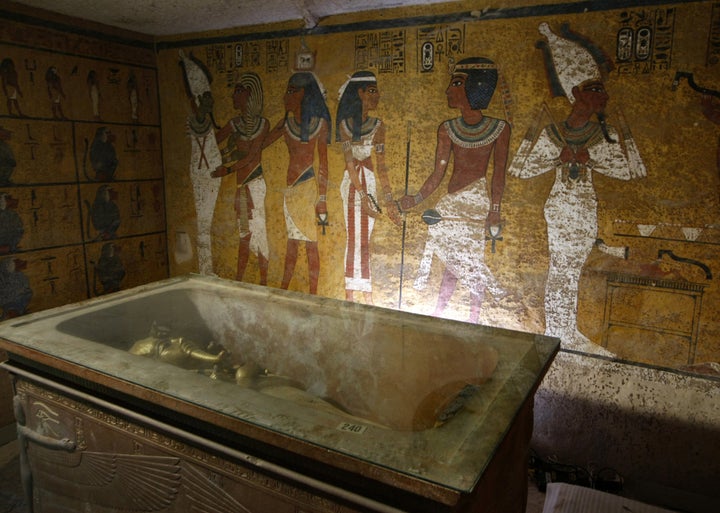One of the greatest mysteries in Egyptology may have just been solved.
The lost tomb of Queen Nefertiti may be hidden undisturbed just behind the burial chamber of King Tutankhamun in the Valley of the Kings, according to a study examining high-resolution scans of the chamber walls.
In a report published by the Amarna Royal Tombs Project, Nicholas Reeves of the University of Arizona said the scans by Factum Arte show two spots that have been patched over.
"Cautious evaluation of the Factum Arte scans over the course of several months has yielded results which are beyond intriguing: indications of two previously unknown doorways, one set within a larger partition wall and both seemingly untouched since antiquity."
Reeves proposes that one entrance leads to a storeroom from Tut's era, while the other leads to an older royal burial chamber: that of Queen Nefertiti herself, who was King Tut's stepmother.
The passage leading to Nefertiti's tomb, if it's indeed there, would be in the wall on the other side of King Tut's sarcophagus:

Archaeologist Nicholas Reeves believes a hidden door in the wall beyond King Tut's sarcophagus leads to Queen Nefertiti's tomb.
While some believe King Tut's final resting place was a small private tomb that was quickly expanded for use by the boy-king after his premature demise, Reeves argues that just the opposite is true.
It's actually a much bigger burial chamber, he writes, one that had been designed for royalty all along -- one that already contained a member of the royal family.
Reeves also argues that the rightward orientation of the tomb, formally known as KV 62, is more consistent with queenly burial chambers than those of kings of that era.
He writes:
"At the time of Nefertiti's burial within KV 62 there had surely been no intention that Tutankhamun would in due course occupy this same tomb. That thought would not occur until the king's early and unexpected death a decade later. With no tomb yet dug for pharaoh's sole use, KV 62 was reopened and accessed up to and including chamber J. This restricted space was then physically enlarged to receive a second burial, with room J -- the notional 'well' of Nefertiti's tomb -- reconfigured to become Tutankhamun's Burial Chamber, or 'House of Gold.'"
Reeves also said some of the paintings in King Tut's chamber appear to have been repurposed, and that one image supposedly of the boy-king has features usually seen only on images of Nefertiti.
He has also previously argued that King Tut's famous gold funerary mask was actually made for a woman, possibly Nefertiti.
Not everyone, however, is convinced that Tut's tomb is hiding another burial chamber.
"I think there are certainly some signs that there might have been some activity around those doorways," Joyce Tyldesley, an Egyptologist with the University of Manchester, told the BBC. "Whether we can deduct from that that we actually [have found] the burial site of Nefertiti might be a step too far. But if it was true, it would be absolutely brilliant."
Most experts agree that this calls for a closer look at the chamber.
“It’s a fascinating argument and an impressive first step,” archaeologist Kent Weeks, who has mapped the Valley of the Kings, told the Economist. He recommended a radar scan of the chamber to see if there were open space beyond the walls.
Reeves wrote in his paper that an examination of the tomb should now be "one of Egyptology's highest priorities."
"If I’m wrong, I’m wrong; but if I’m right this is potentially the biggest archaeological discovery ever made," Reeves told The Economist.
For armchair archaeologists, the high-resolution scans of the chamber wall are available for online examination right here.
Also on HuffPost:
